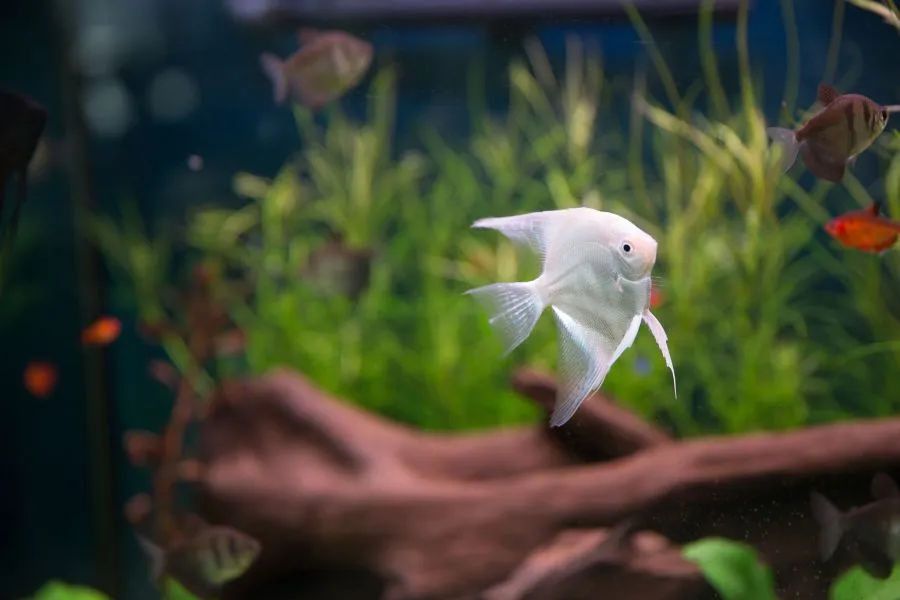Decorating with natural wood will transform your aquarium from a basic to a realistic-looking underwater world. Driftwood doesn’t only have aesthetically pleasing features that will catch the eye, but it also provides a more natural habitat for your freshwater fish. How do you know if your aquarium driftwood is safe?
As natural driftwood can introduce many harmful parasites and bacteria to your tank, you must ensure it’s safe by cleaning or sterilizing it properly. It is possible and safe to place found driftwood in your aquarium, but you should never pick it up and throw it in with your fish right away.

It could be stressful when you need to determine whether or not your piece of driftwood is safe for your aquarium. Stay reading with us as we go through the best kind of safe driftwood for your aquarium and how to clean it correctly.
What Are The Best Kinds Of Driftwood To Use In Aquariums?
If you’re planning on collecting your driftwood for your aquarium, you need to be aware that some types of wood are suitable while others are not. Generally, hardwoods would be ideal for aquariums, but softwoods should be avoided.
This is because softwoods generally contain larger amounts of resin or sap, which could leach out of the wood and into your tank water, causing problems with the water quality your fish needs to live in.

Softwoods will also break down much faster and don’t have the same durability as hardwoods.
It would be best to steer clear of trees such as evergreens and pine, along with any trees that don’t bear cones or shed their leaves.
The problem with scavenging for washed-up driftwood is that you won’t always be able to tell which tree it came from.
However, a good tip to follow would be to try and dig your fingernail into the piece of driftwood. If your fingernail goes into the piece of wood, it indicates a softwood.
If the piece of wood remains firm without your fingernail creating a dent, it’s hardwood and suitable for your aquarium!
Keep in mind that many types of driftwood are particularly prized over others when it comes to using them for an aquarium.
Manzanita driftwood would be ideal, as it naturally contains much fewer tannins, which could discolor your aquarium water.
Malaysian and African driftwood and Savanna root are some of the most popular types, as they sink on their own and don’t need to be weighed down in an aquarium.
Keep in mind that all driftwood must be fully cleaned and sterilized, which is not difficult but could be time-consuming.
If you are unsure if the driftwood is suitable for your aquarium and you don’t know if you have cleaned it properly, never take this risk.
It would then be much better to seek out the perfect piece of aquarium driftwood from your local pet store, as they will mostly be suitable and won’t compromise the lives or health of your fish.
While many types of driftwood are sold at pet stores, not all of them may be suitable for aquarium use, as many are sold as bird cage features and reptiles as well.
When you purchase a piece of driftwood from a pet store, always make sure it is specifically labeled safe for aquarium use, as some reptile driftwoods are sprayed with chemicals or preservatives that could cause your fish harm.

How Can You Prepare Driftwood For Safe Aquarium Usage?
Your aquarium is a highly fragile ecosystem, and the fish living there are sensitive to changes. For this reason, you need to ensure you know how to correctly prepare a piece of driftwood to make it safe for them.
Keep in mind that you need to make sure the desired piece of driftwood is a suitable size to be compatible with your aquarium before preparing it!
Let’s explore how you can make your driftwood safe for your aquarium:
Sterilize The Desired Piece Of Driftwood
Whether you have bought your driftwood from a store or picked it up along the shore, all driftwood should be sterilized before it can be added to your aquarium.
The goal of the cleaning process is to remove any spores, bacteria, or toxins that might be present on the surface of the wood.
The best way to sterilize driftwood should be to boil it for at least one hour and let it cool.
If your piece of driftwood is too large to be placed in a pot, you can also submerge it in a large bucket or container with a 5% bleach solution for between ten and fifteen minutes.
If you decide to use the bleach method, you need to rinse it thoroughly and let it soak again, but in bleach-free water for at least 24 hours.
This will put your mind at ease that any remaining bleach will be gone.
Leaching Your Driftwood After Sterilization
After sterilizing your driftwood, you can add it to your aquarium! However, remember that the driftwood will most probably leach lots of tannins into your tank water, creating a dirty and brown color.
Although this will not affect your fish, most aquarium owners do not prefer this color, as they prefer to create the look of crystal clear and clean water, which is why they leach their driftwood before adding it to their aquarium.
Remember that it will take some time to leach your driftwood, and how long it takes will depend on the wood type and size.
The process will remain the same, and all it takes is to submerge the piece of driftwood in a container and change the water every hour.
After the water in the container no longer changes color, the driftwood is ready for your aquarium and your fish to enjoy.
Conclusion
Driftwood is the ideal addition to any freshwater tank, and it’s not difficult to know whether or not it’s safe for your aquarium, especially if your performed and followed the cleaning process as closely as possible.
Remember, when you’re in doubt, purchasing aquarium-safe driftwood at your local pet store is always better.


